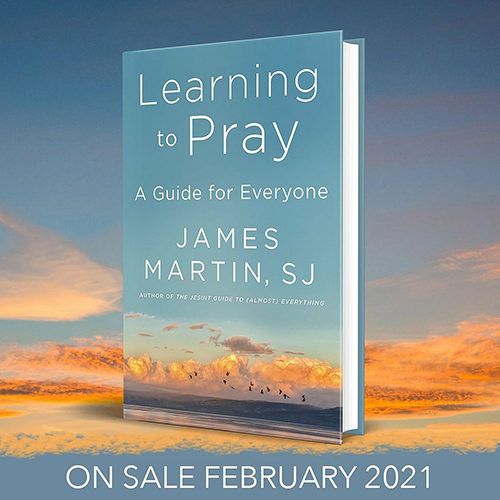First in a series
I first met Father James Martin, S.J., about 15 years ago. His reputation had preceded him. I had read some of his writings and I had heard about some talks that he gave. Not long after I met Father Martin I asked him to write a comment for the cover of a book I had written. He did, and after that, a friendship developed.
I am not exaggerating when I say that Jim is one of the best public representatives of the Church in the United States. In addition to his numerous books, Jim appears regularly on television, (WABC), as a spokesperson for things Catholic. He is an excellent spokesperson: clear, direct, and committed to speaking truthfully. Jim is also editor-at-large for the Jesuit magazine, America. When I learned that he had a book recently published, “Learning to Pray: A Guide for Everyone” (New York: HarperOne, 2021, pp. $27.99, pp.386), I knew I had to get a copy. The title led me to suspect that the book might make perfect reading for me during the pandemic. I was right.
Father Martin’s book is one that I would recommend to just about everyone I know who is looking for reading material.
Novelist Ron Hansen made the following comment about Learning to Pray:
“Witty, conversational, intimate, and inspiring, James Martin’s handbook is the finest, most practical and comprehensive look at prayer that I have ever read”.
I agree completely with Hansen’s comment.
The following are the opening lines of Father Martin’s book:
“Everyone can pray.
Let me put that another way. If I can learn how to pray, then so can you.
If you’ve never prayed before, or have had trouble praying, or think that you’re praying ‘wrong,’ that opening statement might seem hard to believe. Or too good to be true. But it is true, even though it took me a long time to understand this simple fact: prayer is for everyone.”
I would add to Father Martin’s opening words my opinion that I have come to believe that we are never more ourselves, are never more human, more persons, better fulfilling our vocation as God’s creatures, than when we are praying. God created us to be persons who pray.
One of the attractive aspects of Jim’s book is that some sections are very personal with Jim sharing his own experience of prayer but also weaving into his book quotations from other books about prayer. When I finished Learning to Pray, I wondered if there was any book about prayer that Jim has not read. Almost all the books Jim refers to I have never read but Jim’s weaving quotations from those books throughout Learning to Pray seems a special blessing. His choice of quotations is excellent. I found almost all of them insightful and provocative.
As I read both Jim’s texts and the texts Jim quotes I found myself reflecting on them and checking them against my own experience of prayer. I believe that many of Jim’s suggestions will help me as I pray and I plan to discuss them with my spiritual director who is now reading the book. It seems providential that he was reading the book even before I mentioned it to him.
Father Martin is so thorough in discussing prayer, various types of prayer, some difficulties people have in trying to pray, even suggesting why some people do not pray, that as I write this column I realize there is a wealth of material that I want to make available to those who are reading the column.
Father Martin’s insights are a treasure and they are so many that I wish to encourage readers of this column to take a look at Learning to Pray. I suspect that if they do their experience will be similar to mine.
As I read about Father Martin’s experiences in prayer I found myself in his pages.
The book is a wonderful wedding of Jim’s personal experiences but also insights from other authors.
Early on in the book Father Martin writes the following:
“Learning to Pray is written for everyone from the doubter to the devout, from the seeker to the believer. It’s an invitation for people who have never prayed. It’s designed for people who would like to pray, but are worried they’ll do it the wrong way. It’s meant for people who have prayed and haven’t found it as satisfying as they had hoped. It’s also aimed at people who might be afraid of prayer. As I said, prayer can frighten us. It’s unfamiliar territory for some and can be frightening even for believers, because God can seem frightening. …
So for all those who have wanted to pray, this book is written for you.”(pp.9-10)

